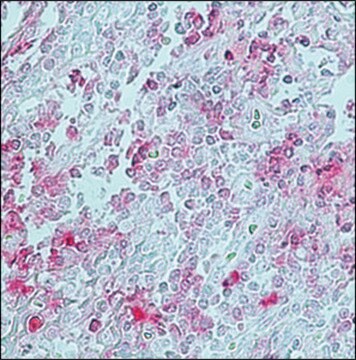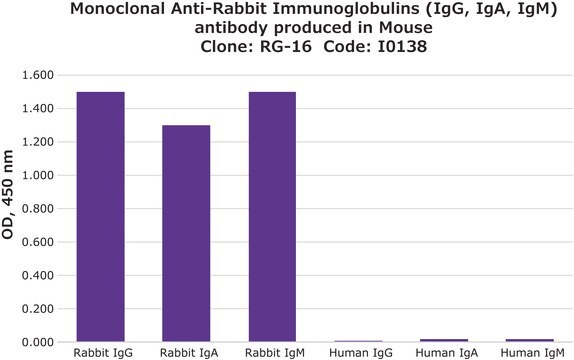A2074
Monoclonal Anti-Rabbit Immunoglobulins–Peroxidase antibody produced in mouse
clone RG-16, purified immunoglobulin, lyophilized powder
Sinonimo/i:
Monoclonal Anti-Rabbit Immunoglobulins (IgG, IgA, IgM)
About This Item
Prodotti consigliati
Origine biologica
mouse
Livello qualitativo
Coniugato
peroxidase conjugate
Forma dell’anticorpo
purified immunoglobulin
Tipo di anticorpo
secondary antibodies
Clone
RG-16, monoclonal
Stato
lyophilized powder
Reattività contro le specie
rabbit
Non deve reagire con
pig, chicken, bovine, horse, human, guinea pig, turkey, rat, canine, goat, feline, sheep
Confezionamento
vial of 0.5 mL
tecniche
direct ELISA: 1:30,000
immunohistochemistry (formalin-fixed, paraffin-embedded sections): 1:100 using human tissue
western blot (chemiluminescent): 1:160,000
Isotipo
IgG1
Temperatura di conservazione
2-8°C
modifica post-traduzionali bersaglio
unmodified
Cerchi prodotti simili? Visita Guida al confronto tra prodotti
Descrizione generale
Specificità
Applicazioni
- western blotting
- immunoblotting
- immunoprecipitation
- enzyme linked immunosorbent assay (ELISA)
- immunohistochemistry
Stato fisico
Nota sulla preparazione
Esclusione di responsabilità
Non trovi il prodotto giusto?
Prova il nostro Motore di ricerca dei prodotti.
Avvertenze
Warning
Indicazioni di pericolo
Consigli di prudenza
Classi di pericolo
Skin Sens. 1
Codice della classe di stoccaggio
11 - Combustible Solids
Classe di pericolosità dell'acqua (WGK)
WGK 2
Dispositivi di protezione individuale
Eyeshields, Gloves, type N95 (US)
Scegli una delle versioni più recenti:
Possiedi già questo prodotto?
I documenti relativi ai prodotti acquistati recentemente sono disponibili nell’Archivio dei documenti.
Il team dei nostri ricercatori vanta grande esperienza in tutte le aree della ricerca quali Life Science, scienza dei materiali, sintesi chimica, cromatografia, discipline analitiche, ecc..
Contatta l'Assistenza Tecnica.









